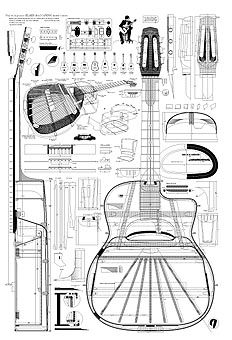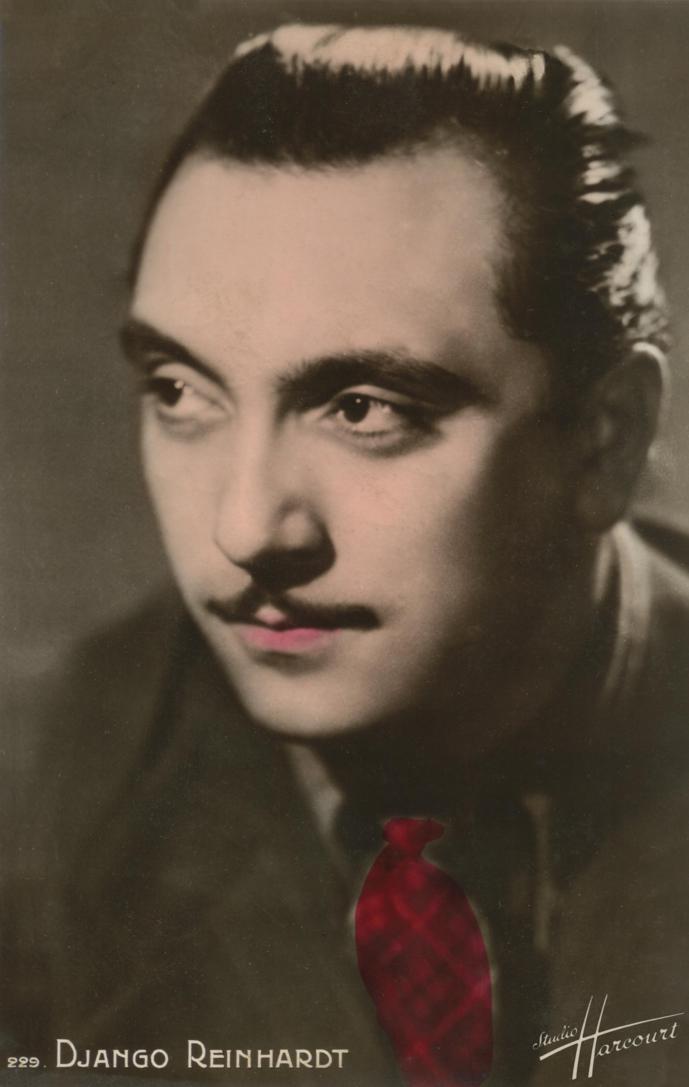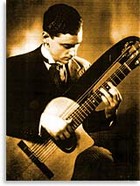|
| |
Selmer-Maccaferri Guitars

Reinhardt and other guitarists of the Quintet of the Hot Club of
France used
Selmer-Maccaferri acoustic guitars
 Selmer
produced guitars between 1932 and 1952. Although they produced a wide variety of
instruments, they are particularly known for the 'Modèle Jazz' ( changed to 'Modèle
Django Reinhardt' later), made famous by Django Reinhardt. Selmer
produced guitars between 1932 and 1952. Although they produced a wide variety of
instruments, they are particularly known for the 'Modèle Jazz' ( changed to 'Modèle
Django Reinhardt' later), made famous by Django Reinhardt.
The guitar was initially designed by Mario Maccaferri, with a 12-fret
neck and a D-shaped sound hole. When Maccaferri left the company, Selmer made
some changes to the model, most notable the introduction of the oval sound hole
and the lengthening of the neck to 14 frets. Almost all Selmer guitars were made
of laminated Indian rosewood with walnut necks and an ebony fingerboard. The
tops are solid French spruce, what defines the sound of the guitar the most
(besides the player). Django Reinhardt got an endorsement
deal with Selmer, so many Selmer guitars passed his hands (he sold or gave away
a lot of them). There are 2 guitars that we are sure of belonged to Django:
n°503 and n°704. N°503 came in Django's possession in 1940 and he played
it until his dead in 1952. The guitar was on display in the Musée Instrumental
de Paris, Alas now removed - see Ade Holland anecdote. N°704 came into his
possession in 1948, just before a tour in Italy. The top was crushed during that
tour and replaced by an Italian luthier.
Django Reinhardt used very light silk-and-steel strings
( .010 to .046) on his guitar.
Django liked to use the thickest guitar picks he could find, most of the
time using natural tortoise shell.
Selmer stopped producing guitars in 1952.
Today Selmer guitars are extremely rare and very much sought after. During the
entire history of Selmer guitars, less than a thousand guitars were made.
Selmer style guitars are reproduced by luthiers like Michael Dunn and John
Kinnard.
 Selmer
guitars were
popularized by the great gypsy jazz guitarist, Django Reinhardt, who
began playing them as soon as they appeared on the market and played
them throughout his career. Today, they are thoroughly associated with
his playing and with gypsy jazz. Few of the Selmer Maccaferri guitars
were ever made, thus they are extremely rare and much sought after. Yet
because they are so significant to the development of 20th century
lutherie, they merit appreciation in a work as comprehensive as possible
in terms of information and illustration Selmer
guitars were
popularized by the great gypsy jazz guitarist, Django Reinhardt, who
began playing them as soon as they appeared on the market and played
them throughout his career. Today, they are thoroughly associated with
his playing and with gypsy jazz. Few of the Selmer Maccaferri guitars
were ever made, thus they are extremely rare and much sought after. Yet
because they are so significant to the development of 20th century
lutherie, they merit appreciation in a work as comprehensive as possible
in terms of information and illustration
The
luthier François Charle was born in Paris in 1949. He is an authority on
Classical, Traditional and Modern French stringed instruments. In 1979
he and his wife Rosyne took over from Daniel and François Sinier de
Ridder the instrument shop and workshop in the Galerie Véro-Dodat, an
historic arcade in the center of Paris. His liking for Selmer-Maccaferri
guitars took a decisive turn when he had the opportunity to buy the
tooling stock of woods and spare parts of the old Selmer workshop. He
became fascinated by the somewhat hazy history behind this guitar and
the myth that is represented. So he threw himself into a ten year long
research project, using archaeological type methods to unearth all the
available information on these mythical guitars. This book is
much more than a compilation of the results of this inquiry into "Django
Reinhardt's guitar", it is a real plunge into a world whose inhabitants
have a passion for instrument making and music.
Henri Selmer and Company - the book now out of
print - outlining the life
and times of the
illustrious guitarist, luthier, and inventor Mario Maccaferri, without
whom there would probably have been no Selmer guitar or story at all.
Key design changes made to the guitar by Selmer craftsmen after Mario
Maccaferri left the company in 1933. Outlines exactly what
differentiates a Selmer guitar from a Selmer "Maccaferri" model and
helps us understand what has heretofore been an obscure body of esoteric
guitar knowledge.
   
   
 During
the 1930's there were many Italian Luthier's settling in France. One who
was to become the most enduring was Mario Maccaferri who was born in
1900. An accomplished guitarist himself, he also had an interest in the
making of many stringed instruments which he had learned as a young man
as an apprentice to the famous Italian luthier Luigi Mozzani which he
took up in 1911. During this period he took an interest in playing the
classical guitar and at the age of sixteen had gained a high reputation
of being a concert guitarist. During
the 1930's there were many Italian Luthier's settling in France. One who
was to become the most enduring was Mario Maccaferri who was born in
1900. An accomplished guitarist himself, he also had an interest in the
making of many stringed instruments which he had learned as a young man
as an apprentice to the famous Italian luthier Luigi Mozzani which he
took up in 1911. During this period he took an interest in playing the
classical guitar and at the age of sixteen had gained a high reputation
of being a concert guitarist.
Even though he had a career as a guitarist he maintained his interest in
the technical side of guitar construction and engineering as a whole as
technical advisor to the Mozzani workshops. In 1926 he received the
highest possible diploma possible from the Academy of Music in Siena.
In 1923 he left Mozzani and embarked on a European tour. During this
period he advertised as the maker of all stringed instruments. In 1926
he settled in London as a teacher and made a comfortable living as such.
While here he began to develop the early prototypes of the Maccaferri
guitars. He took the first prototypes to Ben and Lew Davis who in turn
put him onto Henri Selmer in Paris who was so impressed that he gave him
the contract of setting up a factory in Mante le Ville to build what
were to become the Maccaferri Guitars by Selmer of Paris.
Within a few years these guitars had become popular with Dance Bands and
Jazz Groups across Europe. The most famous of these being Django
Reinhardt and The Hot Club de France.
 In
1934 Maccaferri left Selmer and this is the period most famous for
Selmer as they introduced the Modele Jazz which incorporated the
distinctive small oval hole. Which was used by Django, though not
exclusively, until his death. His brother Joseph played the earlier D
hole, (grand bouche or big mouth), in the Quintet which is still
considered today as the rhythm guitar. In
1934 Maccaferri left Selmer and this is the period most famous for
Selmer as they introduced the Modele Jazz which incorporated the
distinctive small oval hole. Which was used by Django, though not
exclusively, until his death. His brother Joseph played the earlier D
hole, (grand bouche or big mouth), in the Quintet which is still
considered today as the rhythm guitar.
Not many originals were made of this style perhaps only 1,000 between
1932 and 1952 and only half being the Modele Jazz. Rare as rocking horse
shit as they say. Recently I heard of one bought by a Belgian Gypsy for
£4000 it had a neck shaped like a bannana and had to be rebuilt at great
expense by
Doug
Kyle.
The Modele Jazz had a cutaway at the 15th fret incorporated the
compensated floating bridge and two glued on moustache bridge extensions
made from ebony. A metal tailpiece accommodated either ball or loop end
strings, and a radiused ebony fingerboard extending over the soundhole
providing a 24th fret under the high E string.
The Oval hole model with the bouche oval or petite rosace only
appeared after Maccaferri had left the company in 1934. There were a few
odd ball guitars made at this point but settled down eventually to build
the Modele Jazz until their closure in 1952.
Model Jazz Guitar
Selmer No.85 Pictures and Facts
After a
falling out between Mario Maccaferri and the Selmer Company, the petite
bouche (or Oval Hole) was developed. These guitars feature a very long
scale, 670 mm, and feature a 14th fret neck joint. These were used by
Django later on, and are considered by most the "lead guitar" for Gypsy
Jazz.
Maccaferri or Selmer
Mario
Maccaferri 1900-1993
Ray Gallo
son of
Louis
Gallo
Louis was a great teacher and expert on all things Django. He was also a
great friend of Mario Maccaferri and did much to promote the 1970s CSL
Maccaferri remakes. These were the brainchild of Maurice Sommerfield, produced
by Ibanez and approved by Maccaferri himself. The early models are much sought
after instruments. Ray has some photographs of his father with Mario Maccaferri
which may soon be available. These have not been published before! In addition
Louis was a big friend of the Luthier, Marco Roccia who worked for Clifford
Essex music shop in London. He it was who made Selmers from remaining parts
available when the Selmer guitar factory closed. Louis Gallo and Mario went to
France to buy remaining parts stock amongst other luthiers who sought after the
residues.
Internal Resonator
The original
Maccaferri Grande Bouche models featured a wooden resonator behind the
soundhole.
Luthier's Observations
 The guitars designed by Mario Maccaferri and the Selmer Company are some
of the most unique instruments made in the last century. They are an
ingenious combination of flat top and arch top guitars with some of the
qualities of both. They were originally built early in the jazz age when
guitars of greater volume and projection were necessary in order to be
heard over the wind instruments typical to jazz ensembles. Guitar
manufacturers in this country like Gibson and Epiphone were developing
the arch top design that produced a mid-range dominant tone that had the
volume and cutting power necessary for live playing situations, but
these were rare and very expensive in Europe. Mario Maccaferri’s design
produced a guitar with many of the same qualities of tone at a fraction
of the cost. While these are magnificent instruments in their own right,
I contend that we have learned a few things since 1930 that can be
incorporated in Mario’s design to make it better serve the player in the
21st century. The guitars designed by Mario Maccaferri and the Selmer Company are some
of the most unique instruments made in the last century. They are an
ingenious combination of flat top and arch top guitars with some of the
qualities of both. They were originally built early in the jazz age when
guitars of greater volume and projection were necessary in order to be
heard over the wind instruments typical to jazz ensembles. Guitar
manufacturers in this country like Gibson and Epiphone were developing
the arch top design that produced a mid-range dominant tone that had the
volume and cutting power necessary for live playing situations, but
these were rare and very expensive in Europe. Mario Maccaferri’s design
produced a guitar with many of the same qualities of tone at a fraction
of the cost. While these are magnificent instruments in their own right,
I contend that we have learned a few things since 1930 that can be
incorporated in Mario’s design to make it better serve the player in the
21st century.
Mario Maccaferri was a classical guitar performer and luthier who
studied with builder-musician Luigi Mozzani in Cento, Italy. (Francois
Charle, The Story of Selmer-Maccaferri Guitars). The instruments he
built with the Selmer Co. were influenced by this tradition, but Mario
was always an independent and creative thinker. He designed several
models for Selmer, but the two that have become most popular) thanks to
celebrity endorser Django Reinhardt) are the Orchestre Model – known as
the Model Jazz or Grande Bouche- and the Selmer Model known as the
Petite Bouche. Mario’s major innovation on these guitars was the use of
a highly domed top that allowed the bridge to be of sufficient height so
that a tailpiece could effectively be used.
The primary movement of a floating bridge under string tension is
vertical, with very little torque or rock, which is why the tone is
mid-range dominant. The wide, glued on bridge of a flat-top guitar is
driving the soundboard in a more complex way that favours fuller
overtone development. The amount of down-pressure on the bridge greatly
affects both tone and volume. Greater load favours the fundamental pitch
and more volume, while lesser load makes for a richer tone with more
harmonic overtones but somewhat less volume. I build my tailpieces with
height adjustment screws that allow the player to balance the
instruments fundamental/overtone mix by changing the break angle over
the bridge. Bridges on these guitars are hollowed out to reduce mass and
increase volume. Players today prefer much lower action than in the
past, so it is sensible to make the bridge with an in-set saddle for
easy adjustment to various string attack.
 The
dome shape of the top is crucial to the tone and functionality of this
kind of instrument. This dome is accomplished in Maccaferri’s design by
gluing arched braces to the top that run perpendicular to the grain of
the spruce with two short vertical braces under the bridge. This creates
a cylindrical section, with the entire arch in one plane. Forcing the
top down at the neck and tail blocks attains the dome, which creates a
lot of uneven stress on the top. The back is built in a similar way –
like most modern flat tops. The tone of these guitars is predictably dry
and lacking in overtones. In my experience, ladder bracing favours the
fundamental pitch of any note at the sacrifice of the rest of the
overtone range. I believe this is because the top is divided by the
braces into only a few essentially rectangular vibrating plates. Ladder
bracing is used in lute construction, but gluing the braces slightly off
parallel ameliorates this problem. The
dome shape of the top is crucial to the tone and functionality of this
kind of instrument. This dome is accomplished in Maccaferri’s design by
gluing arched braces to the top that run perpendicular to the grain of
the spruce with two short vertical braces under the bridge. This creates
a cylindrical section, with the entire arch in one plane. Forcing the
top down at the neck and tail blocks attains the dome, which creates a
lot of uneven stress on the top. The back is built in a similar way –
like most modern flat tops. The tone of these guitars is predictably dry
and lacking in overtones. In my experience, ladder bracing favours the
fundamental pitch of any note at the sacrifice of the rest of the
overtone range. I believe this is because the top is divided by the
braces into only a few essentially rectangular vibrating plates. Ladder
bracing is used in lute construction, but gluing the braces slightly off
parallel ameliorates this problem.
A better solution is to X brace both the top and the back. This
creates the compound-complex dome in one setting, with minimal stress on
the glue joints of the neck and tail blocks. This allows more of the
plate to be free to move as a unit – the trampoline effect.
Additionally, breaking the soundboard into more odd sized areas
encourages fuller overtone development. It is necessary to support the
bridge with additional X bracing under the tails to prevent collapse
(discovered the hard way). I like to brace the upper bout solidly to
support the fingerboard end for clearer high note playing. It helps to
think of the bracing as creating a top with graduated thickness like a
violin or arch top guitar.
X bracing the back has the effect of re-enforcing bass response
considerably, both in this style guitar and in regular flat tops. When
all the tension of the arch is held by the braces, the back is able to
pump air more freely and efficiently. Add a cross brace between the X in
the lower bout for extra support. The tap tones are very lively with a
back braced like this. The backs of Selmer-Maccaferri guitars were
laminated, but using solid woods is clearly an improvement.
 Use a sanding dish that allows for a 5/16" arch to sand the
interlocked XXX top braces as a unit. They can then be easily go-barred
to the prepared soundboard in the same dish using paper as a pad. Using
more arch risks splintering the plate from too great a stress (the hard
way again). The rib assembly can be shaped for a perfect fit in the
sanding dish too. Rough plane the sides before the linings are attached
using the sanding dish as a pattern. A 4½ degree angle on the blocks is
about right to accommodate the dome. Don’t forget to make a side pattern
for the next time once you’ve got it right. With the ribs in the mould,
rotate on the sandpaper until sanding marks appear on all the linings
and end blocks. Use a sanding dish that allows for a 5/16" arch to sand the
interlocked XXX top braces as a unit. They can then be easily go-barred
to the prepared soundboard in the same dish using paper as a pad. Using
more arch risks splintering the plate from too great a stress (the hard
way again). The rib assembly can be shaped for a perfect fit in the
sanding dish too. Rough plane the sides before the linings are attached
using the sanding dish as a pattern. A 4½ degree angle on the blocks is
about right to accommodate the dome. Don’t forget to make a side pattern
for the next time once you’ve got it right. With the ribs in the mould,
rotate on the sandpaper until sanding marks appear on all the linings
and end blocks.
The
Grande Bouche (Big Mouth) model has much more mid-range tone than a good
flat top guitar, but it is considerably more rich than a good arch top
guitar. The original had a 12 fret neck, and was preferred for rhythm
playing. Most modern makers have given it a 14 fret neck for practical
reasons. The "Model Manouche" has a broader tonal spectrum than ladder
braced instruments, and is more versatile in its uses. The Petite Bouche
(Small Mouth) model has a long 26.25" scale and is preferred for solo
playing. The tone is more treble, being closer to an arch top guitar. I
have been putting a sound port on the upper bass bout that has opened up
the tone of this guitar considerably. Not only can the player hear the
instrument better, it has allowed the box to breath, and increased
volume and responsiveness. That little hole is cute, but it’s just not
big enough to let the sound out. Sound ports are as close as we get in
this world to something for nothing! The "Model Eclipse" is very open
toned and is capable of a wide variety of tone colours.
Selmer-Maccaferri guitars are unique in the world of guitars and deserve
to be toyed with and improved while maintaining the basic character of
the instrument. Would Mozart have used a harpsichord today? The demands
of the modern player sometimes pull us toward change, but often
innovations set a new standard for the musician.
Selmer Maccaferri Reproductions
Godefroy
Maruejouls Guitars
Royal
Jazz Guitars
R
J Aylward Guitars
John
Le Voi Guitars

Powell Guitars-
38 Hillary Road
Newton, Cheshire
SK14 4EA
David
J Hodson Guitars
It is with great sadness that we
learned that UK Luthier David Hodson has passed away. Our
deepest condolences and thoughts are with his family.
Gitane Saga Guitars
|
 The guitars designed by Mario Maccaferri and the Selmer Company are some
of the most unique instruments made in the last century. They are an
ingenious combination of flat top and arch top guitars with some of the
qualities of both. They were originally built early in the jazz age when
guitars of greater volume and projection were necessary in order to be
heard over the wind instruments typical to jazz ensembles. Guitar
manufacturers in this country like Gibson and Epiphone were developing
the arch top design that produced a mid-range dominant tone that had the
volume and cutting power necessary for live playing situations, but
these were rare and very expensive in Europe. Mario Maccaferri’s design
produced a guitar with many of the same qualities of tone at a fraction
of the cost. While these are magnificent instruments in their own right,
I contend that we have learned a few things since 1930 that can be
incorporated in Mario’s design to make it better serve the player in the
21st century.
The guitars designed by Mario Maccaferri and the Selmer Company are some
of the most unique instruments made in the last century. They are an
ingenious combination of flat top and arch top guitars with some of the
qualities of both. They were originally built early in the jazz age when
guitars of greater volume and projection were necessary in order to be
heard over the wind instruments typical to jazz ensembles. Guitar
manufacturers in this country like Gibson and Epiphone were developing
the arch top design that produced a mid-range dominant tone that had the
volume and cutting power necessary for live playing situations, but
these were rare and very expensive in Europe. Mario Maccaferri’s design
produced a guitar with many of the same qualities of tone at a fraction
of the cost. While these are magnificent instruments in their own right,
I contend that we have learned a few things since 1930 that can be
incorporated in Mario’s design to make it better serve the player in the
21st century.